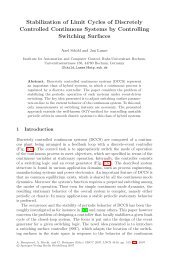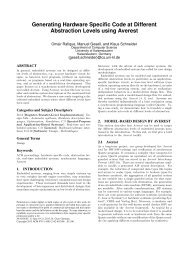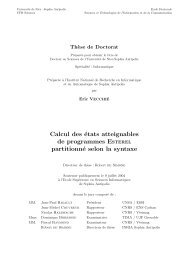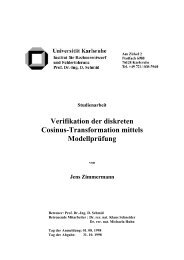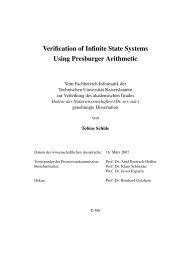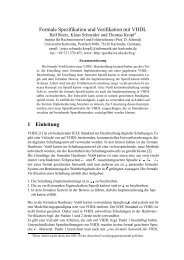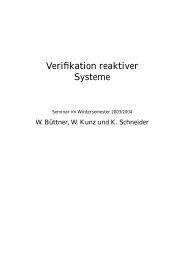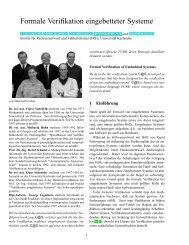Generation of permutations for {SIMD} processors - Embedded ...
Generation of permutations for {SIMD} processors - Embedded ...
Generation of permutations for {SIMD} processors - Embedded ...
You also want an ePaper? Increase the reach of your titles
YUMPU automatically turns print PDFs into web optimized ePapers that Google loves.
The LANCE frontend analyzes a C program, converts it into intermediate<br />
representation (IR), per<strong>for</strong>ms a number <strong>of</strong> optimization<br />
on the IR and saves it. The optimized IR is then processed by the<br />
code generator. Code selection is per<strong>for</strong>med at the level <strong>of</strong> a basic<br />
block. For each basic block <strong>of</strong> the program, a data flow graph<br />
(DFG) is constructed. If some nodes <strong>of</strong> DFG are read by more then<br />
one node, such nodes represent common subexpressions (CSEs),<br />
and the graph is not a tree, but the code generator works at the tree<br />
level, covering one DFT at a time. Thus, to make the graph suitable<br />
<strong>for</strong> OLIVE, it is split into data flow trees (DFTs) at the common<br />
subexpressions, so that each CSE becomes the root <strong>of</strong> a new DFT.<br />
The different operations within a <strong>SIMD</strong> instruction belong to different<br />
DFTs, there<strong>for</strong>e <strong>SIMD</strong> instructions cannot be discovered at<br />
the tree level. They are discovered in the next step, <strong>SIMD</strong>ization,<br />
which is per<strong>for</strong>med after a set <strong>of</strong> optimal covers is computed <strong>for</strong><br />
each DFT <strong>of</strong> the DFG. The code generator attempts to combine<br />
covers <strong>of</strong> different trees into <strong>SIMD</strong> covers, thus further reducing<br />
the cost <strong>of</strong> the basic block cover.<br />
Here is a general <strong>for</strong>mulation <strong>of</strong> the code selection problem using<br />
<strong>SIMD</strong> instructions. Given a data flow graph <strong>of</strong> a basic block and<br />
costs <strong>of</strong> the target architecture instructions, compute a DFG cover<br />
that uses both <strong>SIMD</strong> and non<strong>SIMD</strong> instructions and minimizes the<br />
total cost <strong>of</strong> the basic block.<br />
Since memory address usually must be aligned, the memory<br />
operations (loads and stores) can be grouped into <strong>SIMD</strong> memory<br />
operations so that the resulting group accesses data at an aligned<br />
memory address, each operation accesses data <strong>of</strong> the same size,<br />
and the total size <strong>of</strong> accessed data is equal to the size <strong>of</strong> the <strong>SIMD</strong><br />
register. The individual memory operations in a group are ordered<br />
by their effective address.<br />
The effectiveness <strong>of</strong> using <strong>SIMD</strong> operations depends on the<br />
mapping <strong>of</strong> program objects to memory. The mapping can be optimized<br />
to improve per<strong>for</strong>mance <strong>of</strong> the <strong>SIMD</strong> code [6], but <strong>for</strong> this<br />
work the mapping is considered fixed.<br />
Other operations in the basic block can be grouped arbitrarily,<br />
as long as the groups are valid. A partitioning <strong>of</strong> operations <strong>of</strong> a<br />
basic block into <strong>SIMD</strong> groups is valid if<br />
• operations in each group are compatible with each other, i.e. the<br />
target ISA has an instruction that implements the operations <strong>of</strong><br />
the whole group in one instruction,<br />
• the operations in each group are independent, and<br />
• the groups are schedulable, i.e. if some operation from group A<br />
depends on an operation from group B, no operation from group<br />
B can depend on an operation from group A. In other words, the<br />
DFG <strong>of</strong> the <strong>SIMD</strong> operations is a directed acyclic graph, DAG.<br />
Depending on how the operations are grouped and ordered<br />
within the groups, it may be necessary to insert data reordering<br />
operations, “<strong>permutations</strong>” into the <strong>SIMD</strong> DFG. These operations<br />
add to the cost <strong>of</strong> the basic block and reduce the advantages <strong>of</strong><br />
implementing the basic block with <strong>SIMD</strong> operations. It is possible<br />
that <strong>for</strong> some operation grouping and groups ordering assignment<br />
the resulting <strong>SIMD</strong> code will be less efficient than scalar code.<br />
Thus, assigning operations to <strong>SIMD</strong> groups, determining the<br />
ordering <strong>of</strong> the operations, and inserting <strong>permutations</strong> into the<br />
<strong>SIMD</strong> DFG are related subproblems <strong>of</strong> the optimization problem.<br />
However, this problem as a whole is hard to solve, and thus it<br />
is divided into two subproblems. In the first part, the operations<br />
are assigned to <strong>SIMD</strong> groups. In the second, the ordering <strong>of</strong> the<br />
operations within <strong>SIMD</strong> groups is determined and the <strong>permutations</strong><br />
are inserted as needed.<br />
3.1 <strong>SIMD</strong> Groups<br />
A <strong>SIMD</strong> group is a set <strong>of</strong> operations that can be combined into<br />
an assembly language <strong>SIMD</strong> instruction <strong>of</strong> the target ISA. The<br />
operations in a <strong>SIMD</strong> group must be per<strong>for</strong>med on the same data<br />
type, be independent (not reachable from one another in the basic<br />
block’s DFG), and, if memory operations, must have consecutive<br />
effective addresses accessing adjacent locations.<br />
To specify tree patterns <strong>of</strong> the operations that can be combined<br />
into <strong>SIMD</strong> groups, <strong>SIMD</strong> nonterminals reg8, reg16, etc. are used<br />
in OLIVE rules. These <strong>SIMD</strong> nonterminals denote subregisters <strong>of</strong> a<br />
<strong>SIMD</strong> register. For example, the OLIVE rules <strong>for</strong> 16-bit and 32-bit<br />
additions per<strong>for</strong>med on subregisters <strong>of</strong> a <strong>SIMD</strong> register are:<br />
reg16: PLUS(reg16,reg16)<br />
reg32: PLUS(reg32,reg32)<br />
In these tree patterns, an addition operation reads two values<br />
from subregisters, and saves the result in another subregister. If the<br />
number <strong>of</strong> trees matching this pattern is sufficient to <strong>for</strong>m a <strong>SIMD</strong><br />
group, and all trees are selected to be covered by this pattern, then,<br />
in the <strong>SIMD</strong>ization phase, such non<strong>SIMD</strong> trees are merged into<br />
<strong>SIMD</strong> trees. The number <strong>of</strong> non<strong>SIMD</strong> trees that can be merged<br />
into a <strong>SIMD</strong> tree is equal to the number <strong>of</strong> bits in the <strong>SIMD</strong><br />
register divided by the number <strong>of</strong> bits in the <strong>SIMD</strong> subregister.<br />
For example, Intel SSE registers are 128-bit wide. To <strong>for</strong>m a 32-bit<br />
<strong>SIMD</strong> addition, there must be four 32-bit addition trees. When the<br />
action corresponding to this pattern is invoked, it will generate an<br />
assembly instruction <strong>for</strong> <strong>SIMD</strong> addition, such as parallel addition<br />
<strong>of</strong> 16-bit values paddw or parallel addition <strong>of</strong> 32-bit values paddd<br />
in Intel SSE.<br />
ld x0 x1 x2 x3 y0 y1 y2 y3<br />
op<br />
st<br />
+ + + +<br />
z0 z1 z2 z3<br />
Figure 2. Grouping <strong>of</strong> <strong>SIMD</strong> operations<br />
An operation is a <strong>SIMD</strong> candidate if it matches a pattern that<br />
produces a <strong>SIMD</strong> nonterminal or if it is a store operation and its<br />
data operand is a <strong>SIMD</strong> nonterminal. An example <strong>of</strong> how the DFTs<br />
can be combined into <strong>SIMD</strong> groups is shown in Figure 2. In this<br />
example two vectors x and y are added to produce third vector z.<br />
Each element <strong>of</strong> the vectors is shown separately as x i , y i , and z i . The<br />
operations that <strong>for</strong>m a group are surrounded by a dotted oval. First,<br />
elements x i and y i are loaded from memory (ld groups), then they<br />
are added (op group) and the results are stored into z i (st group).<br />
The memory operations that read x <strong>for</strong>m one load <strong>SIMD</strong> group, and<br />
the memory operations that read y <strong>for</strong>m the other load <strong>SIMD</strong> group.<br />
The memory operations that store z are combined into a store <strong>SIMD</strong><br />
group. The remaining arithmetic operations are also combined into<br />
a <strong>SIMD</strong> group.<br />
The following algorithm is used to <strong>for</strong>m <strong>SIMD</strong> groups. To simplify<br />
grouping, all <strong>SIMD</strong> candidates are sorted by their operation<br />
type. First, the groups <strong>of</strong> memory operations are created. Memory<br />
operations with the same data type are sorted by their effective address.<br />
Then they are split into groups <strong>of</strong> memory operations that<br />
access adjacent locations, so that the total size <strong>of</strong> the data they access<br />
is equal to the size <strong>of</strong> a <strong>SIMD</strong> register, and the address <strong>of</strong><br />
the compound data they access is aligned. The memory operations<br />
are ordered within the groups by their effective addresses. This ap-<br />
LCTES’05, 3 2005/4/16<br />
149




